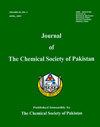ZnO和CuO-TiO2光催化脱除水溶液中的食用染料酒黄石(E102
IF 0.5
4区 化学
Q4 CHEMISTRY, MULTIDISCIPLINARY
Journal of the chemical society of pakistan
Pub Date : 2023-01-01
DOI:10.52568/001283/jcsp/45.04.2023
引用次数: 0
摘要
酒黄石染料在食品以及其他工业产品(如化妆品,个人护理产品,药品等)中发挥着重要作用,因此它是许多环境污染特别是水污染的原因。由于其成分的异质性,用传统技术几乎不可能将其从水体中去除。以氧化锌(ZnO)和氧化铜-二氧化钛(CuO-TiO2)混合为光催化剂,在室温下对食用染料酒黄石(E102)水溶液进行了光催化降解研究。考察了介质pH、辐照时间、染料溶液浓度和催化剂用量等参数对反应的影响。采用Langmuir - Hinshelwood方法进行了动力学分析。E102的光催化降解(PCD)在pH为1时达到最大值。随着辐照时间、染料溶液浓度和催化剂用量的增加,E102的降解率也显著提高。结果表明,ZnO和CuO-TiO2是去除E102水溶液的有效光催化剂。ZnO对E102的降解效果优于CuO-TiO2。本文章由计算机程序翻译,如有差异,请以英文原文为准。
Removal of Food Dye Tartrazine (E102) from Aqueous Solution using ZnO and CuO-TiO2 as Photocatalysts
Tartrazine dye has a major role in food as well as in other industrial products, like cosmetics, personal care products, pharmaceutical products and many more, therefore it is the cause of many environmental pollutions particularly water pollution. Its removal from water bodies is almost impossible with traditional techniques, because of heterogeneity in its composition. This investigation was carried out to examine the photo-catalytic degradation of food dye tartrazine (E102) from its aqueous solution, using ZnO (zinc oxide) and mixed CuO-TiO2 (copper oxide-titanium dioxide) as photo-catalysts at room temperature. The influence of several parameters, such as pH of medium, time of irradiation, concentration of dye solution and amount of catalyst was investigated. Kinetic analysis was also carried out using Langmuir – Hinshelwood approach. Maximum Photo-Catalytic Degradation (PCD) of E102 was observed to be at pH 1. Similarly significant rise in the degradation of E102 was observed with the time of irradiation, concentration of dye solution and amount of catalyst. From the results obtained it was observed that ZnO and CuO-TiO2 are effective photo-catalysts for the removal of E102 from its aqueous solution. However ZnO was observed to be more effective than CuO-TiO2 in the degradation of E102 from aqueous solution.
求助全文
通过发布文献求助,成功后即可免费获取论文全文。
去求助
来源期刊
CiteScore
1.30
自引率
14.30%
发文量
41
审稿时长
3.4 months
期刊介绍:
This journal covers different research areas in the field of Chemistry. These include; Analytical Chemistry, Applied Chemistry, Biochemistry, Environmental Chemistry, Industrial Chemistry, Inorganic Chemistry, Organic Chemistry and Physical Chemistry. The journal publishes full length articles and Reviews from researchers in academia in addition to featuring comments. Chemical Research presents short, concise and critical articles offering easy-to-read overviews of basic research and applications in all areas of chemistry.

 求助内容:
求助内容: 应助结果提醒方式:
应助结果提醒方式:


